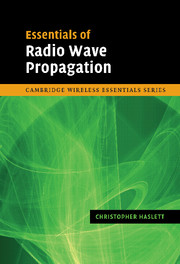Book contents
- Frontmatter
- Contents
- Preface
- Acknowledgements
- 1 Propagation in free space and the aperture antenna
- 2 Point-to-area transmission
- 3 The effect of obstacles
- 4 Reflection, scatter and penetration
- 5 Estimating the received signal strength in complex environments
- 6 Atmospheric effects
- 7 System design and interference management
- 8 Software-based tools
- 9 Summary
- Appendix 1 The decibel scale
- Appendix 2 Phasor arithmetic and phasor diagrams
- Appendix 3 Formula sheet
- Appendix 4 Explanation of the link budget
- Further reading
- References
- Recommendations of the Radiocommunication Bureau of the International Telecommunications Union (ITU), Geneva
- Author's biography
- Index
9 - Summary
Published online by Cambridge University Press: 09 August 2009
- Frontmatter
- Contents
- Preface
- Acknowledgements
- 1 Propagation in free space and the aperture antenna
- 2 Point-to-area transmission
- 3 The effect of obstacles
- 4 Reflection, scatter and penetration
- 5 Estimating the received signal strength in complex environments
- 6 Atmospheric effects
- 7 System design and interference management
- 8 Software-based tools
- 9 Summary
- Appendix 1 The decibel scale
- Appendix 2 Phasor arithmetic and phasor diagrams
- Appendix 3 Formula sheet
- Appendix 4 Explanation of the link budget
- Further reading
- References
- Recommendations of the Radiocommunication Bureau of the International Telecommunications Union (ITU), Geneva
- Author's biography
- Index
Summary
An attempt has been made to provide an insight into the way in which signal strength can be predicted for a variety of situations. Information has been presented with the intention of stimulating an intuitive understanding of radio wave propagation together with essential formulas that will allow rapid estimates of signal strength to be made. It is the sort of information that experienced radio-propagation engineers will carry around in their heads (with the exception of the more complicated equations). Further, detailed information will be gained from consulting more detailed books such as those recommended as further reading and the ITU recommendations (also listed). Further, a radio-propagation engineer will often have software modules available that implement the ITU recommendations and other methods for propagation prediction such as the Okumura–Hata method.
Although radio wave propagation is really a single subject, all the diverse factors that affect the strength of a received signal make a comprehensive calculation of signal strength almost impossible. As a result, radio-propagation engineers concentrate on the factors that have the most significant effect for the circumstances in hand. It is seen that the task of predicting the signal received when propagation is in free space is relatively straightforward and depends upon antenna gains, path length and frequency. The concept of antennas possessing gain, although they are passive devices, is explained: the ‘gain’ is associated with the ability of an antenna to direct the transmitted energy in the required direction and prevent the energy spreading as it travels.
- Type
- Chapter
- Information
- Essentials of Radio Wave Propagation , pp. 182 - 184Publisher: Cambridge University PressPrint publication year: 2007



